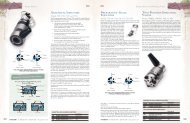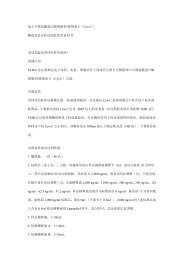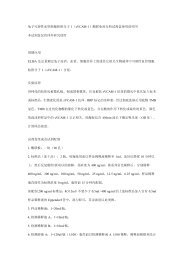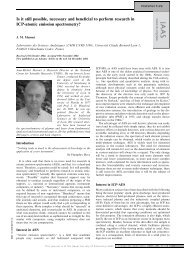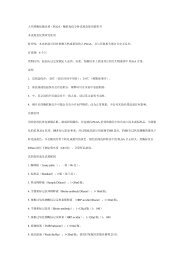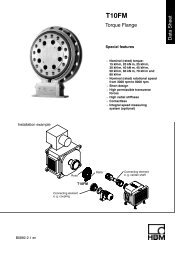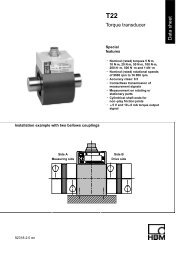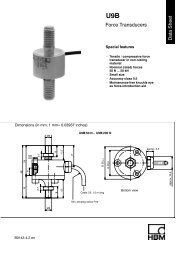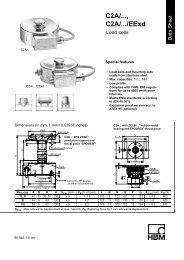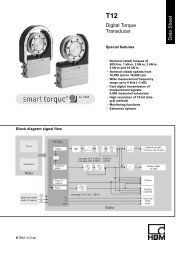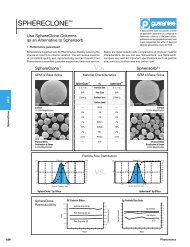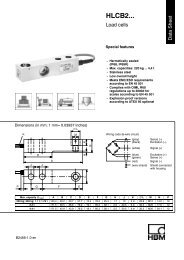CTS-00135 tech data sheet.pub
CTS-00135 tech data sheet.pub
CTS-00135 tech data sheet.pub
Create successful ePaper yourself
Turn your PDF publications into a flip-book with our unique Google optimized e-Paper software.
<strong>CTS</strong>-<strong>00135</strong> Technical Data Sheet<br />
Shimadzu® SPD10A, 10AVP, 10AVVP Deuterium<br />
Lamp<br />
Similar to Shimadzu® 228-34016-02<br />
Chromatography Technology Services Corp.<br />
11975 Portland Ave. S.<br />
Suite 116<br />
Burnsville, MN 55337<br />
1.0 Description<br />
The <strong>CTS</strong>-<strong>00135</strong> Shimadzu® Photodiode Array Lamp Assembly<br />
is pictured in Figure 1. This lamp is a pre-aligned replacement<br />
deuterium lamp for the SPD10A, 10AVP, 10AVVP Photodiode<br />
Array Detectors. It provides the UV light spectrum required by<br />
these Detectors.<br />
2.0 Specifications<br />
2.1 Operating Specifications<br />
Detector type: Diode Array<br />
Light source: Deuterium Lamp<br />
Power consumption: approx 30 Watts<br />
Drift: +/-0.3% per Hour Max.<br />
Discharge Trigger Voltage: More than 400VDC<br />
Tube Drop Voltage: 85 VCD Typical<br />
Operational Anode Current: 300+/-30mADC<br />
Preheat Voltage: 10V +/-1 VDC, AC<br />
Preheat Current: 1.2 ADC, AC<br />
Preheat time: 20 sec.<br />
Operating Voltage: 7.0 V +/-.5 VDC<br />
Operating Current: 1 ADC<br />
Lifetime: 2000 Hours<br />
2.2 Lamp Physical Specifications<br />
Pin Contacts: Phosphor Bronze, Tin Plated<br />
Connector Plug: Nylon 6, White Color<br />
Lamp Envelope: UV Glass (0.4mm)<br />
Aperture Diameter: 0.5mm<br />
Lamp Base: 6061 Aluminum<br />
Wire Sleeving: Fiberglass<br />
3.0 Operating Suggestions<br />
3.1 Lamp Intensity<br />
It is known within the industry that deuterium lamps exhibit reduced<br />
intensity as they age during their normal service life. It is<br />
recommended that a diagnostic test, showing PDA intensity levels,<br />
be run on the lamp at installation, then regularly during the lamp’s<br />
service life. It is also recommended that the lamp be replaced at<br />
50% of original intensity.<br />
3.2 Installation and Transportation<br />
The lamp is sensitive to physical shock such as being dropped.<br />
It is recommended that you avoid shock when installing or<br />
transporting the lamp. If it is suspected that a lamp has been<br />
subjected to excessive shock, it is recommended that a diagnostic<br />
PDA Intensity Test be run to verify that intensity is acceptable.<br />
An acceptable PDA Intensity Test will not, however, guarantee<br />
that no damage occurred.<br />
3.3 Fingerprints<br />
Fingerprints on the glass envelope affect the lamp’s performance.<br />
It is highly recommended that the lamp’s envelope not be<br />
touched unless wearing gloves. If there is any chance that there<br />
are fingerprints on the lamp’s envelope, wipe the envelope with<br />
methanol using a lint-free tissue and allow to dry prior to installation.<br />
3.4 Flow Cells<br />
Figure 1<br />
It is important to clean the flow cell regularly. If the flow cell is<br />
not clean, the amount of light passing through the flow cell may<br />
be insufficient and could affect the light intensity. If after replacing<br />
a lamp the detector performs poorly, it is recommended<br />
that you check to make sure that the flow cell is clean and leak<br />
free.<br />
Tech<strong>data</strong>-a<br />
This business is dedicated to Our LORD
<strong>CTS</strong>-<strong>00135</strong> Technical Data Sheet<br />
Shimadzu® SPD10A, 10AVP, 10AVVP Deuterium<br />
Lamp<br />
Similar to Shimadzu® 228-34016-02<br />
4.0 Warranty<br />
<strong>CTS</strong> guarantees the lifetime of this product for 2000 hours or<br />
one year from purchase date whichever comes first. The guaranteed<br />
lifetime is defined as the time in which the radiant<br />
power of the lamp has dropped to 50% of its initial value measured<br />
at 230nm and 300mA operating current. <strong>CTS</strong> also warrants<br />
the product to be free of defects in materials and workmanship<br />
and will replace, without cost, the product which carries<br />
such defects. Please call 1-800-682-6480 for a Return<br />
Authorization Number before sending your return to <strong>CTS</strong>.<br />
5.0 Lamp Replacement<br />
5.1 General Criteria for Lamp Replacement<br />
a. Lamp will not ignite.<br />
b. Noise or drift exceeds specifications.<br />
c. Dictated by Preventive Maintenance Schedule per<br />
SOP.<br />
d. Lamp energy is below 50% of original intensity as<br />
recorded during initial installation<br />
5.2 Installation Instructions<br />
a. Power down the PDA detector and remove the power<br />
cord.<br />
b. Wait 15 minutes for the detector lamp to cool before<br />
handling the lamp.<br />
c. Access the lamp inside detector housing.<br />
d. Disconnect the lamp power connector.<br />
e. Unscrew the two mounting screws.<br />
f. Grip the metal base and pull the lamp out.<br />
g. Remove the mounting screws from the old lamp.<br />
h. Carefully unpack and hold the replacement lamp by<br />
its base only.<br />
i. Orient the lamp so the two holes in the base align with<br />
the mounting pins and screws in the optics bench.<br />
j. Insert the lamp and secure it with the two mounting<br />
screws.<br />
k. Reconnect the lamp power connector.<br />
j. Close detector housing.<br />
l. Reconnect the power cord and power up PDA<br />
detector.<br />
m. Record initial lamp intensity in the instrument log.



